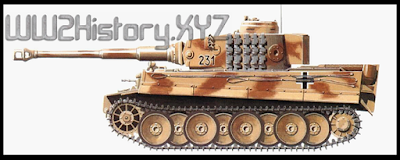As far back as 1938 it has been realized that the PzKpfw IV tank would have to be replaced by a more modern design some time in the future. Various prototypes were built by a number of German companies, but none was placed in production, In 1941 an order was placed with Henschel for a 36 ton tank called the VK 3601 which was required to have a maximum speed of 40 km/h (25 mph), good armor protection and a powerful gun.
 |
| SS Tigers bivouac on the Brenner Pass, guarding the Italian border with Austria. By this time the Allies had landed in Italy and Mussolini had been overthrown. |
A prototype of this tank was built but further work was stopped as an order was placed in May 1941 for a 45-ton tank called the VK 4501, This was to be armed with a tank version of the dreaded 88-mm (3.46-in) AA/anti tank gun, which had then become the scourge of European armies. It was required that the prototype be ready for testing on Hitler's next birthday, 20 April 1942. As time was short Henschel incorporated ideas from the VK 3601 and another tank called the VK 3001(H). The end product was the VK 4501(H), the letter suffix standing for Henschel. Porsche also went ahead with its own design and built the VK 4501(Porsche) to meet the same requirement. Both prototypes were completed in time to be demonstrated on Hitler's birthday, and the Henschel design was selected for production in August 1942 under the designation PzKpfw VI Tiger Ausf E (SdKfz 181).
The Tiger was in production from August 1942 to August 1944, a total of 1,350 vehicles being built. It was then succeeded in production by the Tiger II or King Tiger for which there is a separate entry. In case trials proved the VK 4501(H) a failure, a batch of 90 VK 4501(P) tanks was ordered, and these were subsequently completed as 88-mm (3.46-in) tank destroyers under the designation Panzerjäger Tiger (P) Ferdinand (SdKfz 184). The vehicle was named after its designer, Dr Ferdinand Porsche.
 |
| With its thick armor and a version of the dreaded 88-mm AA anti-tank gun, the PzKpfw VI Tiger was an outstandingly powerful design. It was not a particularly agile machine, but could command the battlefield. |
There were three variants of the Tiger, these being the Tiger command tank (Befehlspanzer Tiger) which was the basic gun tank with its main armament removed, but fitted with a winch but no crane, and the Sturm tiger which had a new superstructure fitted with a 38-cm (14.96-in ) Type 61 rocket launcher with limited traverse; only 10 of the last were built.
For its time the Tiger was an outstanding design with a powerful gun and good armor, but it was also too complicated and therefore difficult to produce. One of its major drawbacks was its overlapping wheel suspension which became clogged with mud and stones. On the Eastern Front this could be disastrous as during winter nights the mud froze and by the morning the tank had been immobilized, often at the exact time the Soviets would attack, When the vehicle travelled on roads a 51.5 cm (20.3-in) wide track was fitted, while a 71,5 cm (28,1 in) wide track was used for travel across country or in combat as this gave a lower ground pressure and so improved traction.
Main armament comprised an 88 mm (3.46-in) KwK 36 gun, with a 7.92-mm (0.31in) MG 34 machine gun coaxial with the main armament and a similar weapon ball mounted in the hull front on the right, Totals of 84 rounds of 88 mm (3.46-in) and 5,850 rounds of machine gun ammunition were carried. The Tiger was first encountered in Tunisia by the British army and from then on appeared on all of the German fronts.
Specification PzKpfw VI Tiger Ausf E
Crew: 5
Weight: 55000 kg (121,250 lb)
Dimensions:
Length (including armament) 8,24 m (27 ft 0 in)
Length (hull) 6.20 m (20 ft 4 in)
Width 3.73 m (12 ft 3 in)
Height 2.86 m (9 ft 3.25 in)
Powerplant: one Maybach HL 230 P 45 12-cylinder petrol engine developing 700hp (522 kW )
Performance:
Maximum road speed 38 km/h (24 mph)
Maximum range road 100 km (62 miles)
Fording 1.2 m (3 ft 11 in)
Gradient 60 per cent
Vertical obstacle 0.79 m (2 ft 7 in)
Trench 1.8 m (5 ft 11 in)
